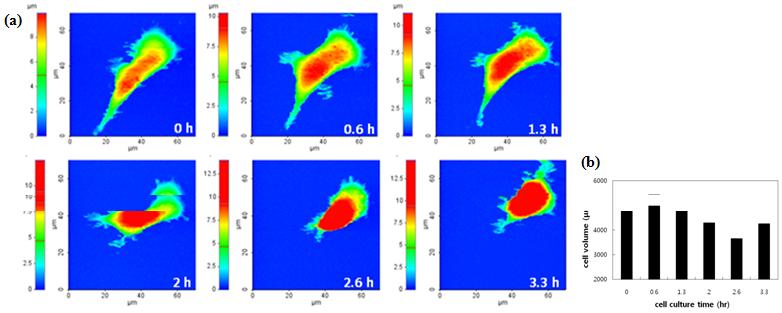Cell Volume Measurement of Scanning Ion Conductance Microscopy
Myunghoon Choi (Research Product Management of Park Systems, Seoul, Korea)
Ion conductance microscopy (SICM)1 is a useful tool for obtaining non-invasive images of cell surface topography. Recently, it has been used for imaging live cells in culture medium2. Cell volume is one of the important factors for cell research because the regulation of cell volume is fundamental to cellular homeostatic mechanism3. SICM can provide accurate volume measurement of cells due to its ability to acquire quantitative dimension information. Furthermore, it can calculate cell volume changes over time caused by physiological environment or its cell status changes. In this paper, live HEK293T cell was successfully imaged and its volume changes monitored using Park SICM.
Human embryonic kidney(HEK) 293T cell was cultured on glass-coverslip in DMEM(dulbeco’s modified eagle medium) with 10% FBS(fetal bovine serum) containing 1% penicillin at 37°C in a 5 % CO2 humidified atmosphere (Multi Gas Cell Incubator, SANYO, JAPAN). Then, the grown cell coverslip was transferred to the Live Cell Chamber installed in the Park XE-Bio (Park Systems). While the cell was being cultured in the live cell chamber (37°C, 5% CO2, and >70% humidity), a live cell’s images were acquired by SICM-ARS mode4. The pipette used for the SICM was pulled from borosilicate glass (O.D.,1.0 mm, I.D., 0.58 mm, length 90 mm;Warner Instruments, US) using a CO2-laser-based micropipette puller (P-2000,Sutter Instruments, Novato, US). The inner and outer diameters of the pipette were about 100 nm and 200 nm, respectively.

Figure 1 (a) Sequential HEK 293T live cell images. It took approx. 0.6 hour to obtain each image, and a total of 3.3 hours for 6 images. (b) Volume change of HEK 293T: the initial cell volume was 5008 μm3; 2.6 hours later it shrank to 3645 μm3.
Cell Volume Analysis Method
Using Park XEI image processing software, the cell volume was calculated from the SICMimage data. After the cell area had been selected, the volume of the chosen area was calculated automatically.

Figure 2 Illustration of the process for the cell volume measurement.
(a) Park SICM image of HEK cell (0.6h) loaded at main frame of Park XEI software.
(b) Cell area selected as pink, marked as ‘1’.
(c) The volume of selected cell area (pink, 1) calculated as 5395 μm3.
Figure 1 is an example that explains how well SICMmeasures cell’s morphology in detail. The SICM images show the whole cell shape clearly including its delicate structures. It even shows the filopodia (the small projections around the cell) distinctively–something that is difficult to be distinguished using optical microscopes. In addition, the quantitative dimension information from the SICM allows the calculation of the cell volume precisely as shown in Figure 2. The cell volume measurement method by SICM gives more quantitative and accurate results compared to the method that monitors reagent like ions or fluorescence dyes with quantitative fluorescence microscopy5 or ion-sensitive microelectrodes6.
Hence, the SICM method gives useful information to cell researches related with hypertrophy. For instance, the quantitative volume measurement provides a new method to analyze and gauge the changes in the cell structure of cardiomyocyte that are frequently accompaniedby the changes in its volume7.
Reference
1P. K. Hansma, B. Drake, O. Marti, S. A. Gould, C. B. Prater, Science 243, 641 (1989).
2Y. E. Korchev, C. L. Bashford, M. Milovanovic, I. Vodyanoy, M. J. Lab, Biophys. J. 73, 653 (1997).
3M. Miragoli, A. Moshkov, P. Novak, A. Shevchuk, V.O. , et al., J. R. Soc. Interface doi:10.1098 (2010).
4C. Myunghoon, K. Ahram, XE-Bio Application Note 1., Park Systems (2012)
5Crowe, W.E., Altamirano, J., Huerto, L.&Alvarez-Leefmans, F.J., Neuroscience 69, 283-296 (1995)
6Alvarez-Leefmans, F.J., Gamino, S.M. & Reuss, L. J. Physiol. 458, 603-619 (1992)
7Dhalla, N.S., Saini-Chohan, H.K., Rodriguez-Leyva, D., Elimban, V.k Dent, M.R. & Tappia, P.S. Cardiovasc. Res. 81, 429-438 (2009)




